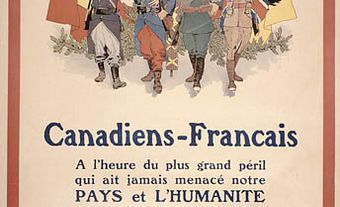The two world wars of the 20th century were total wars that involved the whole nation, and the "home front" became a critical part of Canada’s effort. The home front refers to the civilians, including women, men, children and teenagers, who worked in various ways to help the country cope as tens of thousands of soldiers fought overseas — young men normally employed in factories, on farms and in the cities.
Farms and Factories
In the First World War farmers broke new land and, with state assistance, began to mechanize their operations. Mechanization was one attempt to make up for the shortage of farm help caused by enlistment and by the drift of workers to cities in search of employment in the war industry. City teenagers were sent into the country to assist with the harvest.
At the same time, the booming war factories were in desperate need of skilled tradesmen, too many of whom had been allowed to enlist before their greater value at home had been recognized. One result was that large numbers of women were brought into war factories, and "aliens"— immigrants who were often unacceptable for military service because of their nationality — took factory jobs. Another result of the labour scarcity was that wages rose, although not as much as the cost of living. Yet because conditions in the plants were often terrible, labour unrest was widespread.
Prohibition and Women’s Suffrage
Prohibition on alcohol was a popular measure because it seemed to be a sacrifice that could help the war effort. Women's suffrage, the awarding of voting rights to women, was widely seen as a reward to Canadian women for their help in the war effort. The income tax, an inconceivable measure in 1914, became necessary to help the state finance the staggering costs of war. Even price controls and controls on coal and steel could be justified on the grounds of necessity.
The war had changed much, not least the attitudes of the public. If Prohibition was popular in Canada, it seemed mean-spirited when an attempt was made to apply it to soldiers at the front. But some attitudes died hard. For example, the puritanical morality of the day could scarcely deal with the explosion of venereal disease the war produced. One study at the time attributed the spread of sexually-transmitted diseases to the sudden prevalence of factory girls in the city. Such women were labelled "a disintegrating social force" who spread disease to middle-class men who might in turn infect their wives. The woman, not the man, seemed to be to blame, an attitude that persisted into the 1940s.
Second World War
The home front during the Second World War was much better organized than it had been in the First. In late 1941, the Wartime Prices and Trade Board (WPTB), established in 1939, was given charge of a sweeping system of Wage and Price Controls. This made the rising costs of the First World War an impossibility and, while not everyone was pleased by controls, the public could see the fairness of the system. This was true also with the use of the nation's labour. The institution of National Selective Service in early 1942 effectively controlled the destiny of all men and women, told them who could join up to fight overseas and who could not, where they could work, and when they could change jobs. The WPTB also devised major rationing schemes that distributed meat, butter, oil and gas, and other scarce goods. Inevitably there was a black market for such products but most people regarded it as a social crime.
Children Help at Home
The shortage of consumer goods meant that workers, despite earning good wages for the first time after 10 years of the Great Depression, had little to buy, and the state acted to acquire as much of the people's savings as possible. In the First World War, the minister of finance had been astonished at how much money war bond campaigns raised for the government; by the Second World War, the sums were vastly greater as individuals and companies, in addition to paying higher taxes than ever before, put their money at the service of the war effort. Even school children were urged to purchase war savings stamps, each showing a tank or airplane, for 25 cents. Children also did their bit by collecting cooking fat, bones or milkweed, all of which were necessary for the war effort, while their parents planted victory gardens on waste patches of land, or contributed their old pots and pans for melting down into weaponry.
Opinion surveys demonstrated that by 1944 Canadians had become supporters of a continuation of wartime controls into peacetime. That was undoubtedly a reflection of their concern for the future and their fear of renewed economic depression, but it was also a striking vote of confidence in the fairness of the system the federal government had created. The relatively smooth transition to peace also showed the care with which Ottawa had planned.

 Share on Facebook
Share on Facebook Share on X
Share on X Share by Email
Share by Email Share on Google Classroom
Share on Google Classroom

